This was published 7 years ago
Svalbard, Norway: The island where no one is allowed to die, or give birth
By Kerry van der Jagt
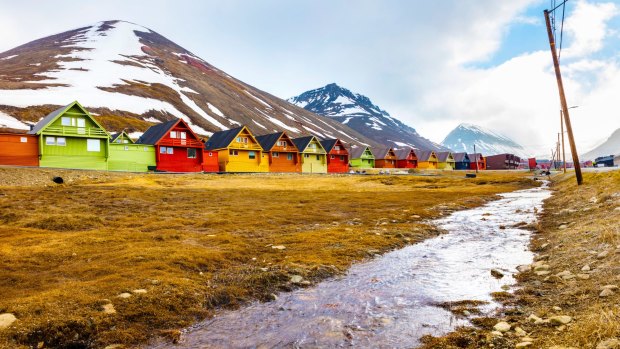
Colorful wooden houses at Longyearbyen in Svalbard.Credit: iStock
Of all the things I'm allowed to do in the Arctic town of Longyearbyen, dying isn't one of them. "The government simply won't allow it," says our guide Hella Liira.
Given that I'm on foot in polar bear country, I draw great comfort from this.
Flanked by armed polar bear guards, our group follows Hella across the tundra near Camp Barentsz, a tiny outpost 10 kilometres outside of Longyearbyen in the Advent Valley on Svalbard's Spitsbergen Island. Penned by muscular mountains, their charcoal flanks still painted with zebra stripes from last winter's snow, the flinty valley is a desolate study in black and white, the bright daubs of our wind jackets the only relief. Above, the sun pirouettes around the heavens, producing 24 hours of perpetual daylight.
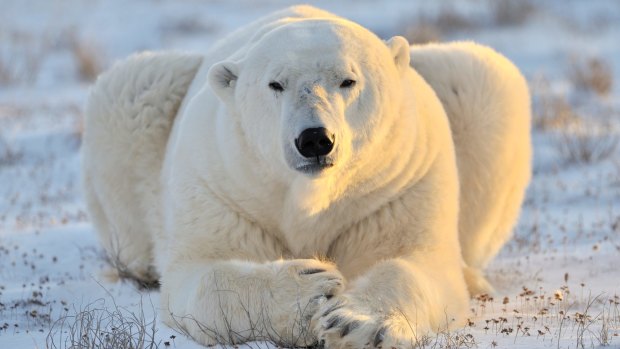
Polar bear lying in the tundra.Credit: iStock
"It's because of the permafrost," explains Hella, continuing her story as the boggy ground makes sucking noises at our boots. "The corpses won't decompose, so they have to be shipped back to the mainland for burial." The town's small graveyard stopped accepting newcomers in the 1950s, partly because it was feared that the cryogenically preserved bodies could still contained traces of the deadly Spanish flu virus that had killed seven miners back in 1918.
Marked by simple white crosses the old cemetery sits at the base of a steep hill, just out of town. Flanked by the skeletal remains of the long abandoned 2b mine and watched over by the icy fingers of a glacier, I doubt there is a more desolate place to be buried.
If dying is out of the question, so too is giving birth. "You can't be born in Longyearbyen," says Hella. "When a woman has three weeks left of her pregnancy, she must go back to the mainland to have her baby." I ask Hella what happens if a baby is born prematurely. "Paperwork," is her deadpan answer.
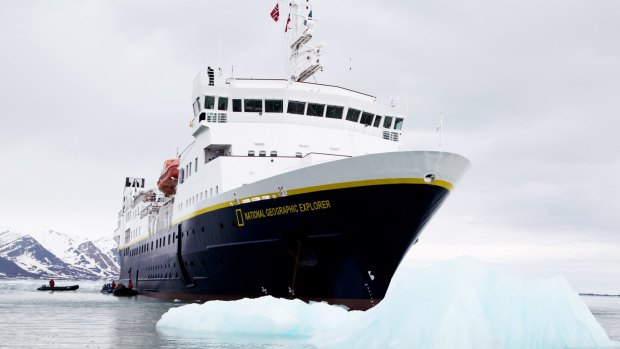
The National Geographic Explorer can accommodate 148 passengers on its Land of the Ice Bear tour. Credit: Kerry van der Jagt
These quirky facts, and more, I learn during a tour of Longyearbyen, the world's northernmost permanent settlement and administrative centre of Svalbard, an archipelago of islands in the Arctic Ocean. It's the final port of call on our Land of the Ice Bears cruise aboard the 148-passenger National Geographic Explorer with Lindblad Expeditions.
Long considered "no man's land", Svalbard's archipelago of islands is so remote (74° to 82° north latitude) that no Indigenous people have ever settled here. To put this into perspective, Churchill in Canada, the other place renowned for seeing polar bears is at 59°N, about the same as Edinburgh in Scotland.
Discovered in 1596 by Dutch explorer William Barentsz it wasn't until 1920 that Norway was granted sovereign control over Svalbard through the Spitsbergen Treaty, a treaty with an unusual clause granting 42 other signatories access to the territory.
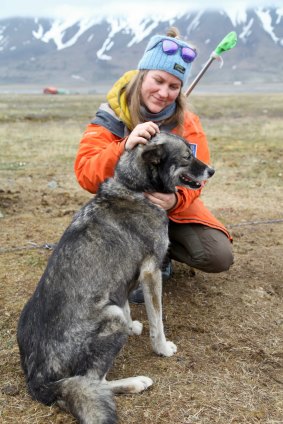
An armed guide enjoys a quiet moment with a husky.Credit: Kerry van der Jagt
The result is a multicultural town, with hundreds of Russians, Chileans, Filipino and Thais living and working here. With the future of Svalbard's mining industry uncertain (due to a downtown in coal prices and environmental conflicts) the town is turning to tourism. Tucking into an authentic hot and sour soup at the Taste of Thai restaurant, on a scrap of ice halfway between Norway and the North Pole, is about as off-kilter as it gets. There's also a brewery (polar beer anyone?), a cafe selling homemade chocolates, a sushi bar, a hotel serving Russian meals and a coal-mining-inspired restaurant in a former mess hall.
And then there's the Doomsday Vault. While permafrost isn't good for burial, it is excellent for preserving plant samples, a fact that has been put to good use with the establishment of the Svalbard Global Seed Vault, a back-up plan against the possibility of a global disaster.
Shrouded in secrecy, we are only permitted to look from a distance, the severe lines of the concrete tomb poking out from the mountainside like some kind of Bond villain's lair. "Syria is the first country to make a withdrawal," explains Hella, "To help replenish and regenerate crops lost during the civil war." Suddenly the vault doesn't seem so fanciful any more.
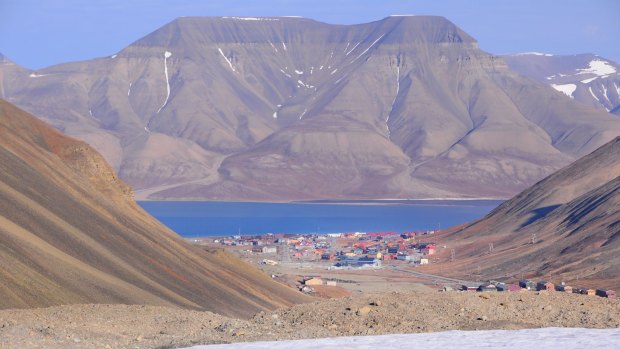
Longyearbyen, Svalbard.Credit: iStock
From Camp Barentsz, with a brief stop to cuddle a team of huskies, we drive back to town, passing docile reindeers and hillsides glazed with flowers. It's the muted colours of these summer tundra plants – moss, mustard, cinnamon and sage – that inspired an artist to select the paintwork for the town's timber houses, huddled like Lego blocks alongside the shifting glaciers.
The 2000 or so people living in Longyearbyen – mainly miners, students, polar scientists and those working in tourism – are a hardy lot; where four months of continual winter darkness is accepted as normal, the carrying of high-powered rifles (outside of settlements) is law, and school camps are really survival lessons in dealing with polar bears. Svalbard, together with the Russian-controlled archipelagos of Franz Josef Land and Novaya Zemlya, is home to about 3000 polar bears, hence the need for precaution.
However, scratch the brittle surface and a softer, creative side is revealed – from the annual jazz festival, held on the first weekend in February, to Galleri Svalbard, an art gallery housed in an abandoned supermarket featuring the works of polar painter Kare Tveter (1922-2012).
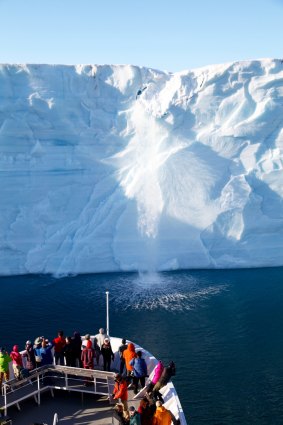
Getting up close and personal with a waterfall on Austfonna ice cap.Credit: Kerry van der Jagt
Documenting Svalbard's polar nights and midnight sun, Tveter produced works such as Arctic Dream, Morning over Glaciers and Svalbard Fantasy, each an interpretation of the Arctic's ever changing light. As much as I'm captivated by the mercurial glow of Tveter's artworks, it's the placement of a lone Grotrian-Steinweg piano, all coltish legs and black thoroughbred lines, which draws me in.
I'm told a long distance ice trekker showed up one day, gave an impromptu jazz concert on the piano, and then continued on his merry way.
This week another musician is in town, Ludovico Einaudi, a world-renowned Italian pianist and composer, who has just returned to Longyearbyen after giving the concert of his life. The only clue to Einaudi's solo performance is Greenpeace's ship Arctic Sunrise, which sits defiantly off shore in all her rainbow glory, nodding and heaving on the swell.
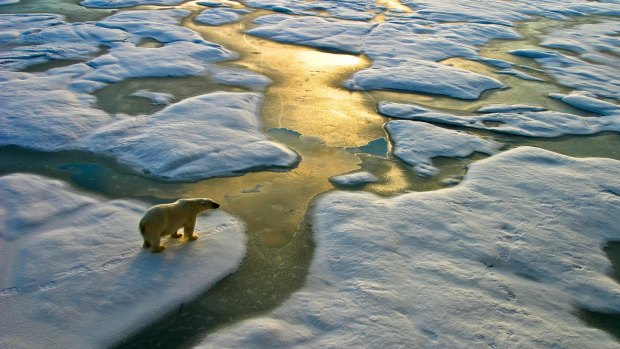
"A wake-up call that the earth is warming and it's warming substantially in the Arctic.'Credit: iStock
Having travelled from the Netherlands to Longyearbyen, Arctic Sunrise took Einaudi (and his baby grand) out to a floating platform in the middle of the ice so he could play Elegy for the Arctic, an original composition designed to raise awareness about climate change. His performance was designed to transform the voices of the 8 million people who lent their signatures to Greenpeace's Save the Arctic campaign into music.
After a week circumnavigating Svalbard – watching polar bears leaping between ice floes, kayaking alongside icebergs and chasing waterfalls along the Austfonna ice cap on Nordaustlandet – it's impossible not to feel the urgency to protect the Arctic. On-board lectures by Emeritus Fellow Andrew Clarke, a scientist who worked for the British Antarctic Survey for 40 years, painted a grim picture about global warming and how sea-ice is melting at an unprecedented rate. And without the sea ice, we'd lose the polar bears, which rely on the ice for hunting, resting, travelling and breeding.
When ice cover decreases polar bears become trapped on land for longer and this is when the trouble, for both humans and bears, begins. In April this year a hungry polar bear appeared in Longyearbyen, on the beach, not far from the centre of town. "He had to be tranquillised, have his rudimentary tooth removed [to estimate age] and loaded into the governor's rescue helicopter for relocation," says Hella. "Imagine how the pilot felt with a sleeping polar bear behind him."
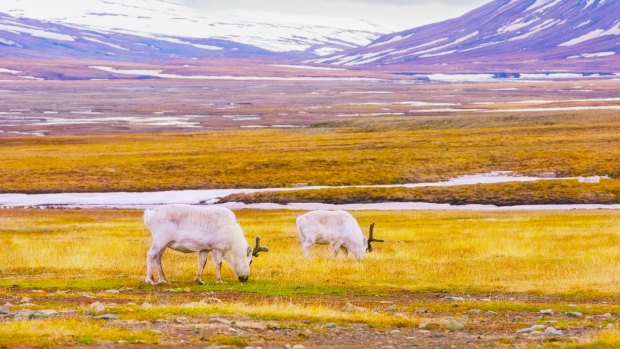
Reindeer grazing in the advent valley - Adventdalen in Svalbard. Credit: iStock
Later that afternoon I take to the skies on a charter flight back to Oslo, the sky flush with the ghostly glow I've grown to love. Flying low over snowy, meringue-pie peaks, the plane shifts and shakes from turbulence, a sensation that usually fills me with dread. But today I'm fearless; safe in the knowledge that dying in Svalbard isn't allowed. Imagine the paperwork.
TRIP NOTES
MORE
traveller.com.au/cruisesvisitsvalbard.com
FLY
Thai Airways flies from Sydney and Melbourne to Oslo via Bangkok. See thaiairways.com. Longyearbyen is a three-hour flight from Oslo.
CRUISE
Lindblad Expeditions offers a 10-day Land of the Ice Bears: An in-depth exploration of Arctic Svalbard from $12,780 to $23,610, including two nights in Oslo, meals, excursions and charter flights to/from Longyearbyen (international flights excluded). Tours depart May and June. See expeditions.com
Kerry van der Jagt was a guest of Lindblad Expeditions
FIVE THINGS TO DO IN LONGYEARBYEN
VISIT THE MUSEUM
A state-of-the-art, interactive museum in Longyearbyen showcases Svalbard's cultural, scientific and natural history. See svalbardmuseum.no
TAKE A DAY TRIP
On a boat, or snowmobile, depending on the season, to the abandoned Soviet-era settlement of Pyramiden. See visitsvalbard.com
ALL THAT JAZZ
Time your trip to coincide with the world's northernmost jazz festival. Held in Longyearbyen over the first weekend in February, the festival attracts national and international performers. See polarjazz.no
GO WITH THE DOGS
Combine dogsledding with a trip to an ice cave or glacier. Trips are available summer and winter (in summer the huskies pull wheeled carts) offered as half-day, full-day or overnight tours. See greendog.no
LIGHT UP
See the Northern lights dance across the sky during the polar nights from November to February. See visitsvalbard.com
See also: Nine places tourists love that I don't
Sign up for the Traveller Deals newsletter
Get exclusive travel deals delivered straight to your inbox. Sign up now.